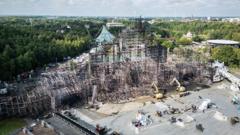The restoration of Notre-Dame Cathedral is not merely about repairing damage but aims to enhance the historic structure's beauty while ensuring structural integrity. From the newly restored spire to the vibrant stained glass, and ground-breaking archaeological findings, this journey highlights a confluence of tradition and modern technology.
Revival of Notre-Dame: The Restoration Journey Post-Fire

Revival of Notre-Dame: The Restoration Journey Post-Fire
A deep dive into the ambitious restoration of Notre-Dame Cathedral following the devastating 2019 fire.
The recent restoration of Paris's iconic Notre-Dame Cathedral has successfully brought new life to the centuries-old structure which suffered catastrophic damage in a fire in April 2019. French President Emmanuel Macron shared a televised tour showcasing significant renovations that have transformed the cathedral into a work of art again, merging the old with the new.
The rebuilding process started by focusing on the spire, which was initially constructed under the supervision of the architect Eugène Viollet-Le-Duc in the 19th century, and collapsed during the fire. Craftsmen today balanced traditional carpentry methods with modern techniques, using high-tech tools to create a new wooden base for the spire, which was installed using one of Europe’s largest cranes. The topping of the spire included a golden rooster that now encases holy relics.
One of the more striking features of Notre-Dame's renovation is the luminosity of the limestone, with thorough cleaning revealing features lost to years of dirt and grime. Experts sourced replacement stones from northern France and meticulously cleaned approximately 40,000 square meters of existing masonry, returning the cathedral’s grandeur.
Additionally, the wooden roof, which was consumed by flames, was replaced with 1,200 oak trees sourced from French forests, adhering as closely as possible to the original design. Remi Fromont’s studies played a crucial role as carpenters employed historical techniques in creating the supporting structures.
On the artistic front, the restoration team has undertaken extensive work on sculptures and the stained-glass windows, which had accumulated decades of soot. Many of the distinct gargoyles were restored, replacing damaged parts through careful scanning and re-design, while the stained-glass windows were systematically removed, cleaned, and delicately reinstalled.
Among the more remarkable discoveries during the restoration was the excavation that revealed significant archaeological finds dating back to the construction of the cathedral. This included remnants of an ancient rood-screen and burial sites, offering a rich insight into the cathedral's history that enhances the narrative of its restoration.
While the progress so far has been notable, work continues. The ongoing renovations not only promise to restore Notre-Dame's vitality but also aim to create an inviting space for generations to come. Plans for further architectural and historical showcases are set to unfold, intending to enrich visitor experience and preserve the storied legacy of this treasured landmark.























